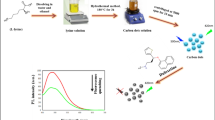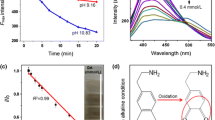Abstract
In this investigation, a simple, green and facile fluorescence mrtod using carbon dots (CDs) of hazelnut kohl is described for selective detection of dopamine (DA). The sensing system is based on hazelnut kohl (the black soot of kohl) which is used as a carbon source. Generally, kohl is a traditional eye cosmetic that used in different parts of the world and synthesized by the combustion process like burning natural materials. Here, it has been proven that black soot (kohl) obtained from hazelnut has a carbon dot structure and can be used for sensory applications. Some characterization methods are carried out to reveal the kohl structure. Also, the photoluminescence properties of the prepared CDs of kohl are investigated. It is found that the size of CDs is 2–4 nm. Besides, under the optimal conditions, the fluorescence of CDs is used for DA determination. CDs fluorescence intensity is decreased linearly with the increase of DA concentration. By using the fluorescence dependency toward the DA concentration, DA can be determined in the range 0.5–30 μM with the limit of detection of 0.30 μM. Finally, this method is successfully applied to discriminate the DA in the real samples (healthy human serum and cerebrospinal fluid (CSF)) which shows acceptable efficiently for diagnostic purposes.
Graphical abstract

The fluorescence of carbon dots, prepared from Hazelnut Kohl, is quenched in the presence of dopamine






Similar content being viewed by others
References
Foroughi F, Rahsepar M, Kim H (2018) A highly sensitive and selective biosensor based on nitrogen-doped graphene for non-enzymatic detection of uric acid and dopamine at biological pH value. Journal of Electroanalytical Chemistry 827:34–41
Zhu L, Xu G, Song Q, Tang T, Vang X, Wei F, Hu Q (2016) Highly sensitive determination of dopamine by a turn-on fluorescent biosensor based on aptamer labeled carbon dots and nano-graphite. Sensors and Actuators B: Chemical 231:506–512
Zhou X, Ma P, Wang A, Yu C, Qian T, Wu S, Shen J (2015) Dopamine fluorescent sensors based on polypyrrole/graphene quantum dots core/shell hybrids. Biosensors and Bioelectronics 64:404–410
Lewis MM, Huang X, Nichols DE, Mailman RB (2006) D1 and functionally selective dopamine agonists as neuroprotective agents in Parkinson’s disease. CNS & Neurological Disorders-Drug Targets (Formerly Current Drug Targets-CNS & Neurological Disorders) 5(3):345–353
Wu D, Xie H, Lu H, Li W, Zhang Q (2016) Sensitive determination of norepinephrine, epinephrine, dopamine and 5-hydroxytryptamine by coupling HPLC with [Ag (HIO6) 2] 5–luminol chemiluminescence detection. Biomedical Chromatography 30(9):1458–1466
Zen JM, Chen PJ (1997) A selective voltammetric method for uric acid and dopamine detection using clay-modified electrodes. Analytical Chemistry 69(24):5087–5093
Li L, Liu H, Shen Y, Zhang J, Zhu JJ (2011) Electrogenerated chemiluminescence of Au nanoclusters for the detection of dopamine. Analytical Chemistry 83(3):661–665
Zheng V, Wang Y, Yang X (2011) Aptamer-based colorimetric biosensing of dopamine using unmodified gold nanoparticles. Sensors and Actuators B: Chemical 156(1):95–99
Halawa MI, Wu F, Fereja TH, Lu B, Zu G (2018) One-pot green synthesis of supramolecular β-cyclodextrin functionalized gold nanoclusters and their application for highly selective and sensitive fluorescent detection of dopamine. Sensors and Actuators B: Chemical 254:1017–1024
Das P, Ganguly S, Bose M, Mondal S, Dus AK, Banerjee S, Dus NC (2017) A simplistic approach to green future with eco-friendly luminescent carbon dots and their application to fluorescent nano-sensor ‘turn-off’ probe for selective sensing of copper ions. Materials Science and Engineering 75:1456–1464
Mao Y, Bao Y, Han D, Li F, Niu L (2012) Efficient one-pot synthesis of molecularly imprinted silica nanospheres embedded carbon dots for fluorescent dopamine optosensing. Biosensors and Bioelectronics 38(1):55–60
Sahu S, Behera B, Maiti TK, Mohapatra S (2012) Simple one-step synthesis of highly luminescent carbon dots from orange juice: application as excellent bio-imaging agents. Chemical Communications 48(70):8835–8837
Li F, Liu C, Yang J, Vang Z, Liu W, Tian F (2014) Mg/N double doping strategy to fabricate extremely high luminescent carbon dots for bioimaging. RSC Advances 4(7):3201–3205
Liu Y, Liu C, Zhang Z (2012) Synthesis of highly luminescent graphitized carbon dots and the application in the Hg2+ detection. Applied Surface Science 263:481–485
He YS, Pan CG, Cao HX, Yoe MZ, Wang L, Liang GX (2018) Highly sensitive and selective dual-emission ratiometric fluorescence detection of dopamine based on carbon dots-gold nanoclusters hybrid. Sensors and Actuators B: Chemical 265:371–377
Zhang X, Zhang Y, Wang Y, Kalytchung S, Kershaw SV, Wang Y, Wang P, Zhang T, Zhao Y, Zhang H, Cui T, Wang Y, Zhao J, Yu WW, Rogach AL (2013) Color-switchable electroluminescence of carbon dot light-emitting diodes. ACS nano 7(12):11234–11,241.
Baker SN, Baker GA (2010) Luminescent carbon nanodots, emergent nanolights. Angewandte Chemie International Edition 49(38):6726–6744
Essner JB, Kist JA, Parada L, Baker GA (2018) Artifacts and errors associated with the ubiquitous presence of fluorescent impurities in carbon nanodots. Chemistry of Materials 30(6):1878–1887
Li X, Wang H, Shimizu Y, Pyatenko A, Kawaguchi K, Koshizaki N (2010) Preparation of carbon quantum dots with tunable photoluminescence by rapid laser passivation in ordinary organic solvents. Chemical Communications 47(3):932–934
Liu H, Ye T, Mao C (2007) Fluorescent carbon nanoparticles derived from candle soot. Angewandte Chemie 46(34):6473–6475
Tian L, Gosh D, Chen W, Pradhan S, Chang X, Chen S (2009) Nanosized carbon particles from natural gas soot. Chemistry of materials 21(13):2803–2809
Bourlinos AB, Stassinopoulos A, Anglos D, Zboril R, Geoegakilas V, Giannelis EP (2008) Photoluminescent carbogenic dots. Chemistry of Materials 20(14):4539–4541
Sharma V, Bhardwaj S, Kumar R (2019) On the spectroscopic investigation of Kohl stains via ATR-FTIR and multivariate analysis: Application in forensic trace evidence. Vibrational Spectroscopy 101:81–91
Ullah PH, Mahmood ZA, Sualeh M, Zoha SM (2010) Studies on the chemical composition of kohl stone by X-ray diffractometer. Pak J Pharm Sci 23:48–52
Said E, Shafey E, Al-Kitani BS (2017) Comparative chemical analysis of some traditional Omani-made kohl. Toxicological & Environmental Chemistry 99(2):233–251
Guo X, Wu F, Ni Y, Kokot S (2016) Synthesizing a nano-composite of BSA-capped Au nanoclusters/graphitic carbon nitride nanosheets as a new fluorescent probe for dopamine detection. Analytica chimica acta 942:112–120
Chibac AL, Melinte V, Buruiana T, Buruiana EC (2017) Fluorescent polymeric sensors containing boronic acid derivatives for sugars and dopamine detection Sensing characteristics enhancement by Au NPs. Sensors and Actuators B: Chemical 253:987–998
Medintz IL, Stewart MH, Trammell SA, Susumo K, Delehanty JB, Mei BC, Melinger JS, Belanco- Canosa JB, Dowson PE, Mattoussi H (2010) Quantum-dot/dopamine bioconjugates function as redox coupled assemblies for in vitro and intracellular pH sensing. Nature materials 9(8):676–684
Ji X, Palui G, Avellini T, Na HB, Yi C, Knappenberger KL, mattoussi H (2012) On the pH-dependent quenching of quantum dot photoluminescence by redox active dopamine. Journal of the American Chemical Society 134(13):6006–6017
Zhao D, Song H, Hao L, Liu X, Zhang L, Lev Y (2013) Luminescent ZnO quantum dots for sensitive and selective detection of dopamine. Talanta 107:133–139
Naghashian-Haghighi A, Hemmateenejad B, Shamsipur M (2018) Determination of enantiomeric excess of some amino acids by second-order calibration of kinetic-fluorescence data. Analytical biochemistry 550:15–26
Tripathi KM, Tran TS, Tung TT, Losic D, Kim TY (2017) Water soluble fluorescent carbon nanodots from biosource for cells imaging. Journal of Nanomaterials 2017:1–10
Zhuang Q, Cao W, Ni Y, Yang Y (2018) Synthesis-identification integration: One-pot hydrothermal preparation of fluorescent nitrogen-doped carbon nanodots for differentiating nucleobases with the aid of multivariate chemometrics analysis. Talanta 185:49–498
McEnally CS, Pfefferle LD, Atakan B, Kohse-Hoinghaus (2006) K Studies of aromatic hydrocarbon formation mechanisms in flames: Progress towards closing the fuel gap. Progress in Energy and Combustion Science 32(3):247–294
Zhang S, Zhang L, Huang L, Zheng G, Zhang P, Jin Y, Jiao Z, Sun X (2019) Study on the fluorescence properties of carbon dots prepared via combustion process. Journal of Luminescence 206:608–612
Alas MO, Genc R (2017) An investigation into the role of macromolecules of different polarity as passivating agent on the physical, chemical and structural properties of fluorescent carbon nanodots. Journal of Nanoparticle Research 19(5):185
LiQuin L, YuanFang L, Lei Z, Yue L, ChengZhi H (2011) One-step synthesis of fluorescent hydroxyls-coated carbon dots with hydrothermal reaction and its application to optical sensing of metal ions. Science China Chemistry 54(8):1342–1347
Klegeris A, Korkina LG, Greenfield SA (1995) Autoxidation of dopamine: a comparison of luminescent and spectrophotometric detection in basic solutions. Free radical biology and medicine 18(2):215–222
Zhao J, Zhao L, Lan C, Zhao S (2016) Graphene quantum dots as effective probes for label-free fluorescence detection of dopamine. Sensors and Actuators B: Chemical 223:246–251
Massart D, Vandeginste B, Deming S, Michotte Y, Kaufman L (1998) Chemometrics: A textbook. Elsevier, Amsterdam, pp. 107–114.
Zhao C, Jiao Y, Hua J, Yang J, Yang Y (2018) Hydrothermal synthesis of nitrogen-doped carbon quantum dots as fluorescent probes for the detection of dopamine. Journal of fluorescence 28(1):269–276
Mu Q, Xu H, Li Y, Ma S, Zhong X (2014) Adenosine capped QDs based fluorescent sensor for detection of dopamine with high selectivity and sensitivity. Analyst 139(1):93–98
Kim YR, Bong S, Kang YJ, Yang Y, Mahajan RK, Kim JS, Kim H (2010) Electrochemical detection of dopamine in the presence of ascorbic acid using graphene modified electrodes. Biosensors and Bioelectronics 25(10):2366–2369
Devi JA, Aswathy B, Asha S, George S (2017) Lactose tailored boronic acid conjugated fluorescent gold nanoclusters for turn-on sensing of dopamine. Analytical chemistry 72(4):445–459
Qu F, Huang W, You J (2018) A fluorescent sensor for detecting dopamine and tyrosinase activity by dual-emission carbon dots and gold nanoparticles. Colloids and Surfaces B: Biointerfaces 162:212–219
Niu S, Fang Y, Zhang K, Sun J, Wan J (2017) Determination of dopamine using the fluorescence quenching of 2, 3-diaminophenazine. Instrumentation Science & Technology 45(1):101–110
Availability of Data and Materials
Not applicable.
Funding
The work is funded by Shiraz University Research Council.
Author information
Authors and Affiliations
Contributions
Neda Chavoshi; design the work, acquiring data and preparing first draft.
Bahram Hemmteenejad; Conceptualization, supervision, validation and writing the final draft.
Corresponding author
Ethics declarations
Competing Interests
There are nothing to declare
Additional information
Publisher’s Note
Springer Nature remains neutral with regard to jurisdictional claims in published maps and institutional affiliations.
Supplementary Information
ESM 1
(DOCX 232 kb)
Rights and permissions
About this article
Cite this article
Chavoshi, N., Hemmateenejad, B. Fluorescent Carbon Dots Prepared from Hazelnut Kohl as an Affordable Probe for Determination of Dopamine. J Fluoresc 31, 455–463 (2021). https://doi.org/10.1007/s10895-020-02668-y
Received:
Accepted:
Published:
Issue Date:
DOI: https://doi.org/10.1007/s10895-020-02668-y




